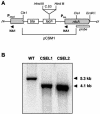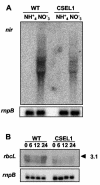HetR-dependent and -independent expression of heterocyst-related genes in an Anabaena strain overproducing the NtcA transcription factor
- PMID: 15743946
- PMCID: PMC1064053
- DOI: 10.1128/JB.187.6.1985-1991.2005
HetR-dependent and -independent expression of heterocyst-related genes in an Anabaena strain overproducing the NtcA transcription factor
Abstract
Heterocyst development in the cyanobacterium Anabaena sp. strain PCC 7120 depends on both the global nitrogen control transcription factor NtcA and the cell differentiation regulatory protein HetR, with expression of ntcA and hetR being dependent on each other. In this study we constructed strains that constitutively express the ntcA gene leading to high levels of NtcA protein irrespective of the nitrogen source, and we analyzed the effects of such NtcA levels on heterocyst differentiation. In the NtcA-overproducing strain, heterocyst differentiation, induction of NtcA-dependent heterocyst development genes or operons such as devBCA or the cox2 operon, and NtcA-dependent excision of the 11-kb nifD-intervening element only took place under nitrogen deficiency. Although functional heterocysts were produced in response to nitrogen step-down, the NtcA overproducing strain could not grow diazotrophically. Overexpression of ntcA in a hetR background promoted expression of devBCA in response to ammonium withdrawal and excision of the 11-kb element even in the presence of combined nitrogen. Our results show that some NtcA-dependent heterocyst-related genes can be expressed independently of HetR.
Figures





References
-
- Amann, E., B. Ochs, and K. J. Abel. 1988. Tightly regulated tac promoter vectors useful for the expression of unfused and fused proteins in Escherichia coli. Gene 69:301-315. - PubMed
-
- Ausubel, F. M., R. Brent, R. E. Kingston, D. D. Moore, J. G. Seidman, J. A. Smith, and K. Struhl. 2003. Current protocols in molecular biology. Greene Publishing/Wiley-Interscience, New York, N.Y.
-
- Black, T. A., Y. Cai, and C. P. Wolk. 1993. Spatial expression and autoregulation of hetR, a gene involved in the control of heterocyst development in Anabaena. Mol. Microbiol. 9:77-84. - PubMed
-
- Buikema, W. J., and R. Haselkorn. 1991. Characterization of a gene controlling heterocyst differentiation in the cyanobacterium Anabaena 7120. Genes Dev. 5:321-330. - PubMed
Publication types
MeSH terms
Substances
LinkOut - more resources
Full Text Sources
Research Materials

